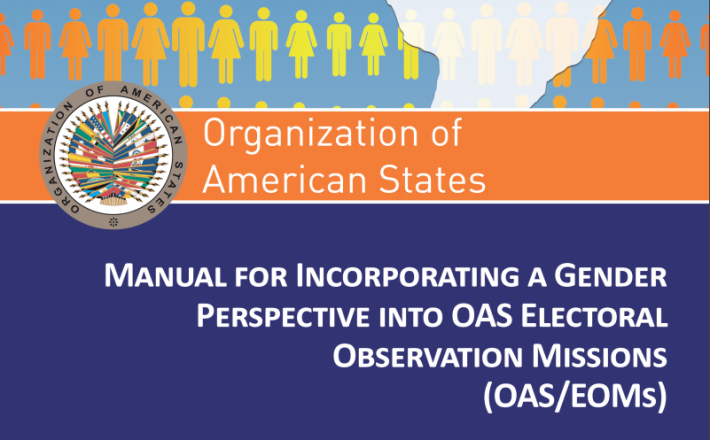Manual for Incorporating a Gender Perspective into OAS Electoral Observation Missions
The methodology for incorporating a gender perspective into OAS/EOMs presented in this manual provides OAS international electoral observation with the technical tools for a careful examination of equitable participation by men and women throughout the electoral process. Other methodologies developed in recent years have similarly focused on equity in electoral races.
The underpinning of this new tool is the conviction that equality and nondiscrimination are cornerstones of democracy, the rule of law and full respect for human rights. From this point of view, the methodology for incorporating a gender perspective into OAS/EOMs is an instrument that enables Electoral Observation Missions to assess compliance with the commitments made by OAS member states, in both national and international legislation, to promote the political participation of women.
The first part of this manual presents a conceptual framework, which is divided into two sections. The first section provides an overview of the principles and precepts on the political participation of women established in both the international and Inter-American human rights system. The second section explains how a gender perspective has been incorporated into the four criteria of a democratic election, according to the OAS definition. That section defines inclusiveness, cleanliness, competitiveness, and elective public office from a gender perspective.
The second part of the manual presents a methodological framework. It sets forth criteria such as the scope and procedures for observation, data and sources of information, the functions of OAS/EOM members, and the steps to be followed during each observation stage. Lastly, the third part of the manual describes the necessary tools for observing elections from a gender perspective.
Lastly, it bears noting that the incorporation of a gender perspective in international electoral observation is more than an institutional obligation for OAS/DECO; the inclusion of gender has fundamentally enriched the democracy strengthening work carried out by the OAS General Secretariat through its electoral observation missions. The most important aspect of this endeavor is the potential for recommendations emitted in electoral observation missions to encourage member states to undergo efforts to transform the asymmetrical relationship between men and women in the political arena, in order to generate stronger, more inclusive, and more representative democracies in the region.
Click here to access the publication.

The methodology for incorporating a gender perspective into OAS/EOMs presented in this manual provides OAS international electoral observation with the technical tools for a careful examination of equitable participation by men and women throughout the electoral process. Other methodologies developed in recent years have similarly focused on equity in electoral races.
The underpinning of this new tool is the conviction that equality and nondiscrimination are cornerstones of democracy, the rule of law and full respect for human rights. From this point of view, the methodology for incorporating a gender perspective into OAS/EOMs is an instrument that enables Electoral Observation Missions to assess compliance with the commitments made by OAS member states, in both national and international legislation, to promote the political participation of women.
The first part of this manual presents a conceptual framework, which is divided into two sections. The first section provides an overview of the principles and precepts on the political participation of women established in both the international and Inter-American human rights system. The second section explains how a gender perspective has been incorporated into the four criteria of a democratic election, according to the OAS definition. That section defines inclusiveness, cleanliness, competitiveness, and elective public office from a gender perspective.
The second part of the manual presents a methodological framework. It sets forth criteria such as the scope and procedures for observation, data and sources of information, the functions of OAS/EOM members, and the steps to be followed during each observation stage. Lastly, the third part of the manual describes the necessary tools for observing elections from a gender perspective.
Lastly, it bears noting that the incorporation of a gender perspective in international electoral observation is more than an institutional obligation for OAS/DECO; the inclusion of gender has fundamentally enriched the democracy strengthening work carried out by the OAS General Secretariat through its electoral observation missions. The most important aspect of this endeavor is the potential for recommendations emitted in electoral observation missions to encourage member states to undergo efforts to transform the asymmetrical relationship between men and women in the political arena, in order to generate stronger, more inclusive, and more representative democracies in the region.
Click here to access the publication.